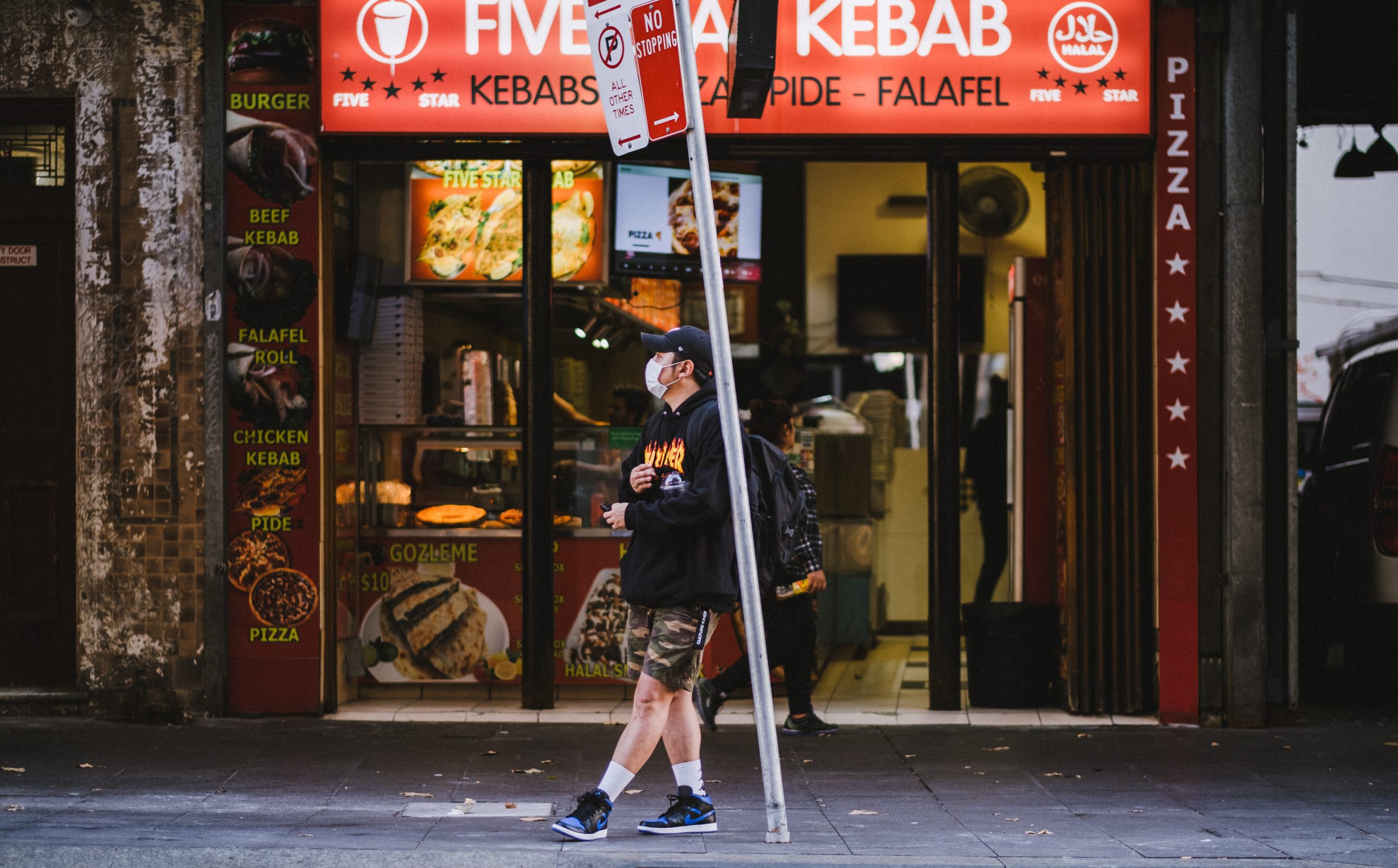
The Future of Restaurant Design
In a world impacted by COVID-19, restaurant design is evolving and adapting to the new normal. As restrictions are lifted and dining rooms reopen, returning diners will want reassurance around safety. Restaurants must demonstrate their new emphasis on sanitation and social distancing. In this post we look at the design features that will make the so-called “third-wave” restaurants smaller, sleeker, faster, and ultimately, more successful.
Inventive Access
The new customer experience starts at the restaurant entrance, with many establishments modifying traffic flow by designating specific doors for entry or exit, reconfiguring the guest queuing area, changing the nearness of restrooms, and dining area access. The idea is that the dine-in and take-out customer journeys are distinct and require their own dedicated space. Revolving doors are a big congestion point, so they are either removed, or it must be made clear that it is for entrance only. It’s becoming more common to bypass entry to the building completely with the addition of walk-up windows for takeout. Curbside is becoming extremely popular, and many restaurants are moving to digital menus at parking stalls for carside service, or just moving to a drive-thru model. In the future it is likely that drive-thru lines will be for pick-up only– no ordering, credit cards, or cash.
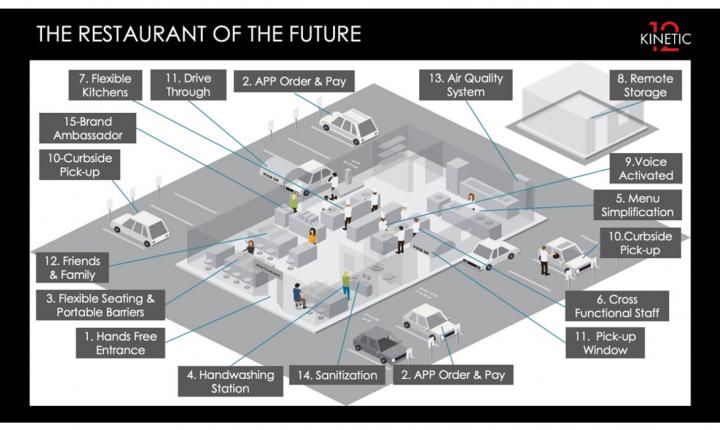
Restaurant of the Future by Kinetic12
Dine-In Innovations
While sit-down and fine dining establishments are more prepared for social distancing with their permanent booths, in fast-casual and quick service there is a shift away from communal seating and cafeteria-style dining. Community tables may still exist, but dividers will be installed to separate groups. In the future, we expect barstools to be fixed. Plus, there will be more hand-washing stations and built-in sanitizing wipe stations that allow customers to wipe down surfaces, with clear signage identifying their locations. Condiments, fountain beverages, and menu ordering will be touch-free. Across the board, restaurants will move away from soft surfaces and porous hard surfaces to nonporous materials that are easy to clean like stainless steel, porcelain, plastic-based fabrics, and laminate. With regards to acoustics, loudness signals to customers that the restaurant is too crowded and too much spread is happening. With loud environment making patrons anxious, acoustics may cease to be value engineered out of projects.
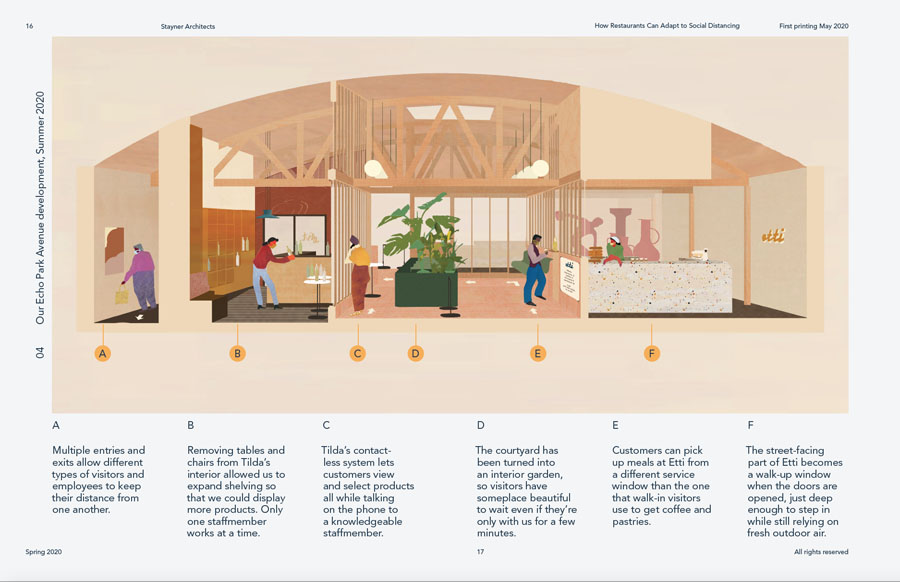
Post-Covid Restaurant Design by Stayner Architects
Open kitchens and lines where meals are prepared in front of customers allow customers to see back of house cleanliness. Unsurprisingly, bars will probably become deeper and sneeze guards taller. Again, anti-microbial surfaces will be commonplace in the restaurant of the future– porcelain is bleach-cleanable, and copper is naturally antibacterial. In the kitchen, equipment such as microwaves that already have touch screens may become “no-touch” screens. Flooring used in hospitals might be used more frequently in restaurants. Restaurant back of house is traditionally tight so that every square inch is used. However, front of house can be used for some prep work. Two production lines may exist with the flexibility to close one during slower periods. Creative approaches for dine-in including private rooms or reserved areas, or interactive events. Creative concepts that minimize time spent inside the restaurant will also become more prevalent. Rather than leaving patio design as an afterthought, many restauranteurs are focusing on making outdoor dining areas more comfortable and dynamic. Additional offerings include walk-up windows and bars that allow food and beverage pickup without going inside.
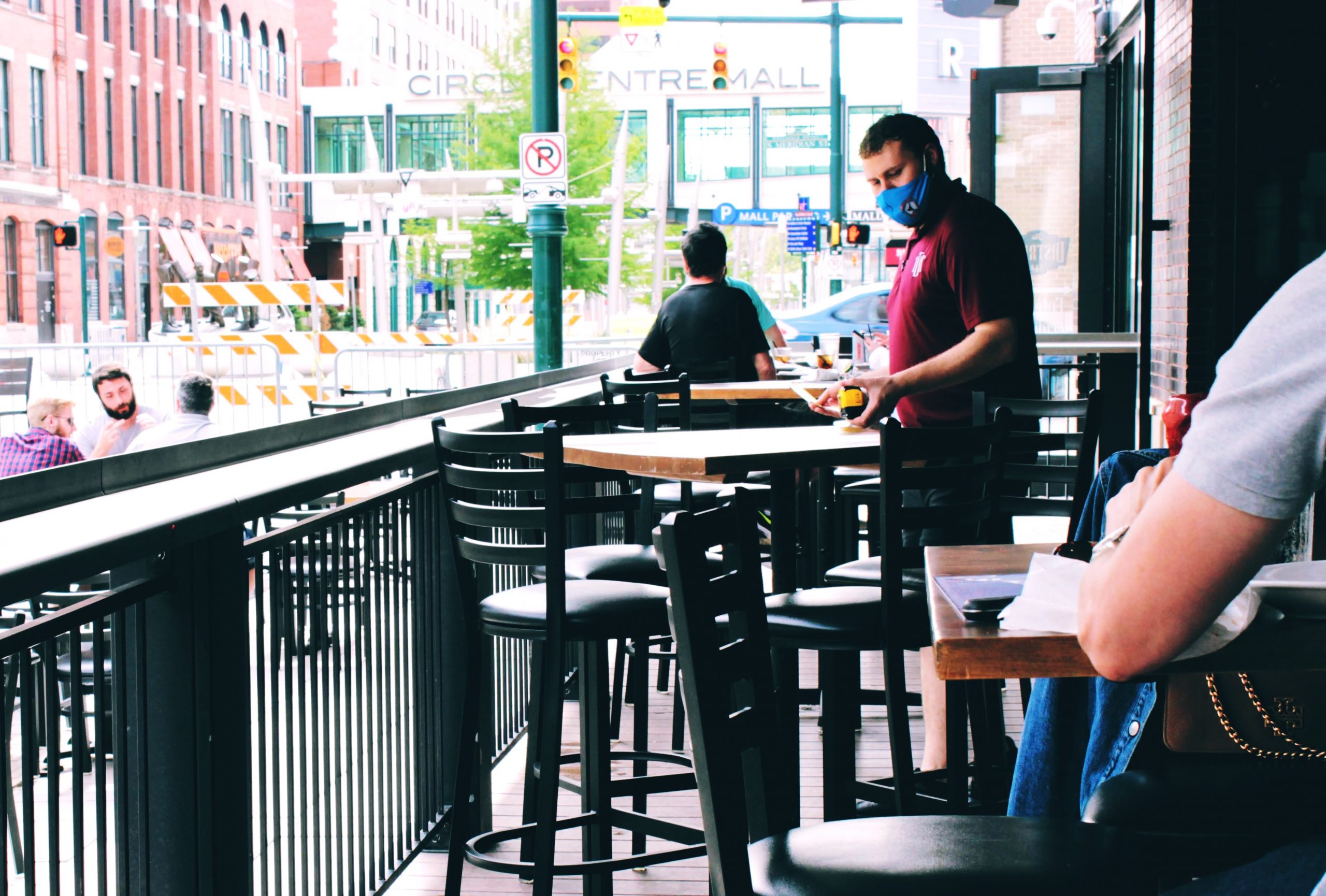
Improved Air
While no mechanical system can completely eliminate the spread of viruses, they can help to reduce the risk of transmission when they are designed to enhance indoor air quality. Some restaurants, for example, are increasing the amount of their HVAC ducts by a significant percentage– the more outside air that is brought in, the more diluted any pollutants will be indoors. Additionally, upgraded air filters better remove particles that pollutants attach to, resulting in cleaner air. Even higher safety can be achieved with a system that uses 100% outside air for make-up air and 100% exhaust. Studies show that displacement ventilation systems enhance indoor air quality. Air quality monitors can be installed to track key air quality parameters that most affect the comfort and health of customers.
Restroom Enhancements
Restrooms will see massive change to battle infection. Fully exhausted restroom stalls with full height dividers will increase sanitation. Ceiling UV lights may be implemented, and unsurprisingly, all fixtures will be touch-free. Restroom cubicles may be open and closed by foot or wireless sensors.
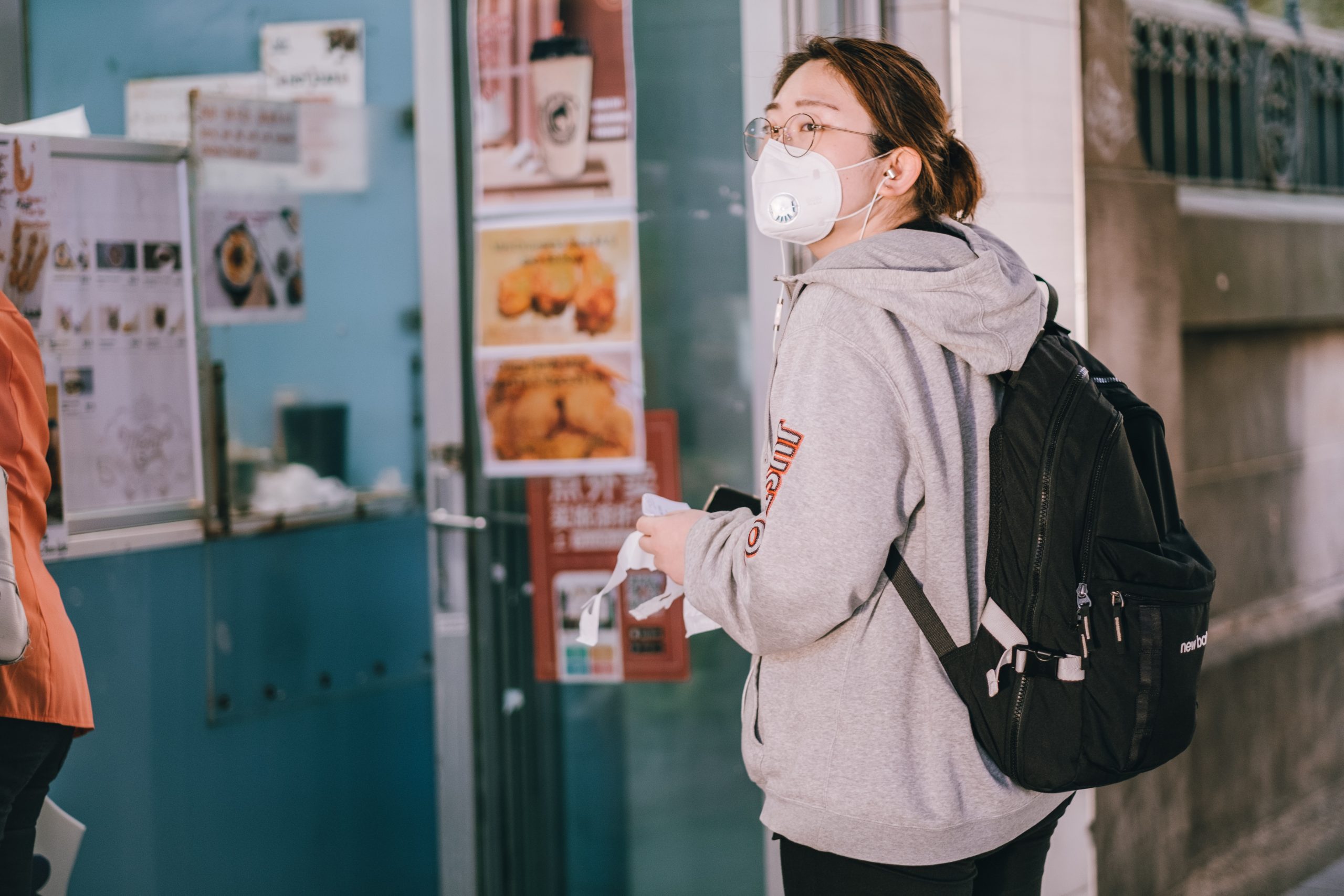
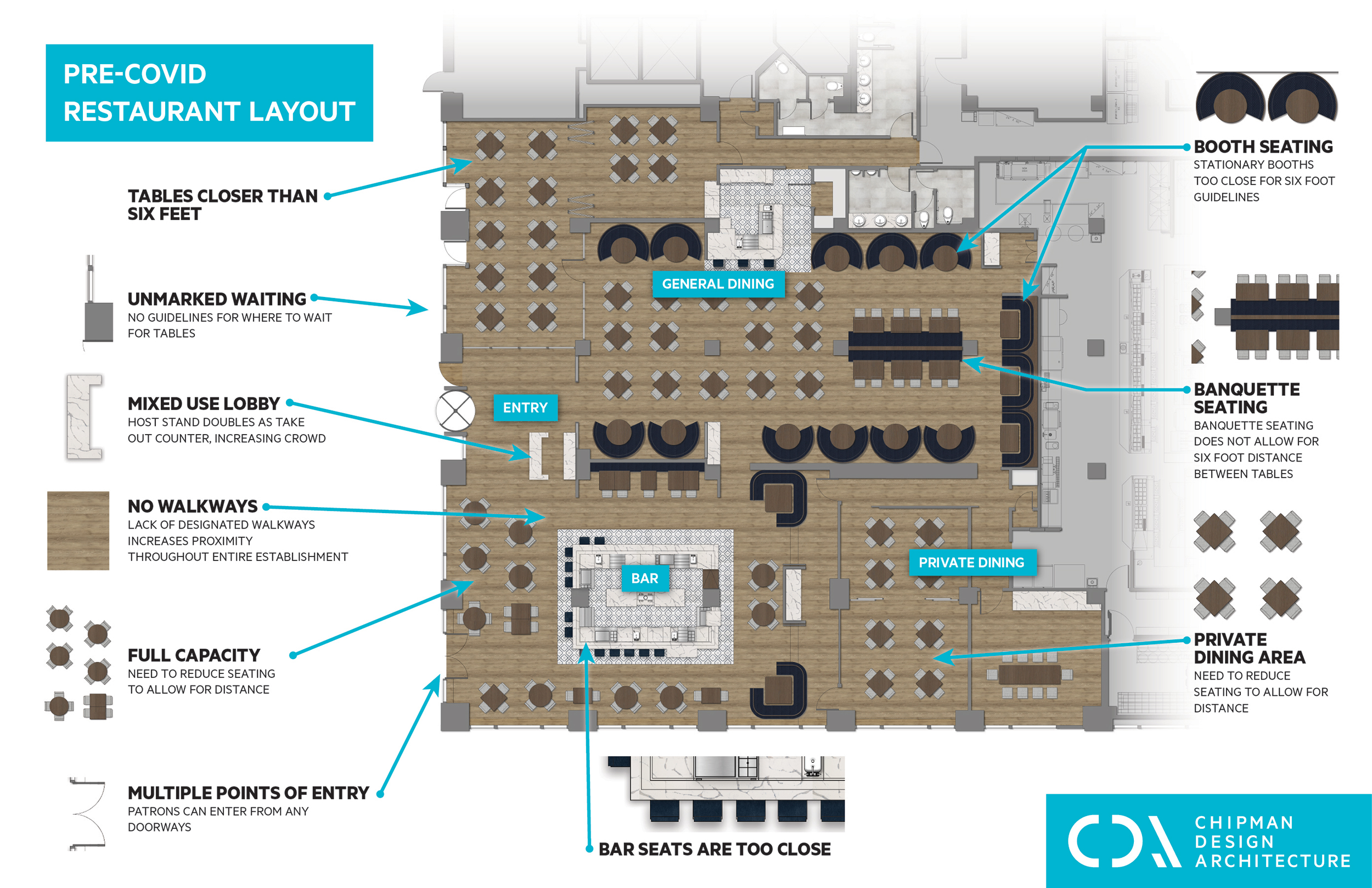
Pre-Covid Restaurant Layout by Chipman Design Architecture

Post-Covid Restaurant Layout by Chipman Design Architecture

Reviving Dead Space
Ghost kitchens had already increased in popularity prior to the pandemic. Now, their adoption will likely increase drastically. Yes, there are zoning and land-use requirement challenges, but if goverments step in and make things easier, unused infrastructure will be be converted into usable space. Retail-zoned spaces can bring in far more revenue than a light industrial space. Hybrid space that operates mostly as a ghost kitchen but have a storefront, retail pickup area may become more common. In the end, it’s easier to reconfigure existing kitchens than it is to start from scratch.
Conclusion
While it may be difficult to precisely predict the specifics of the future of restaurant design, one thing is certain- restaurants of the future will be designed for maximum flexibility. New features will be implemented in response to the ever-changing consumer and operator needs. Hopefully restaurant operations become so efficient that upgrades and changes go unnoticed by customers. Ultimately, new build outs and remodeled restaurants don’t need to look sterile. In fact, maximalist interior design may rise in order to make the dining experience more of an escape. Restaurants of the future will be innovative and exciting. Emerald Inc. is experienced in building restaurants that conform to the new normal. In order to update your restaurant or to design and build a new one that excels in an environment, contact us today at 480-832-9808, or email us.
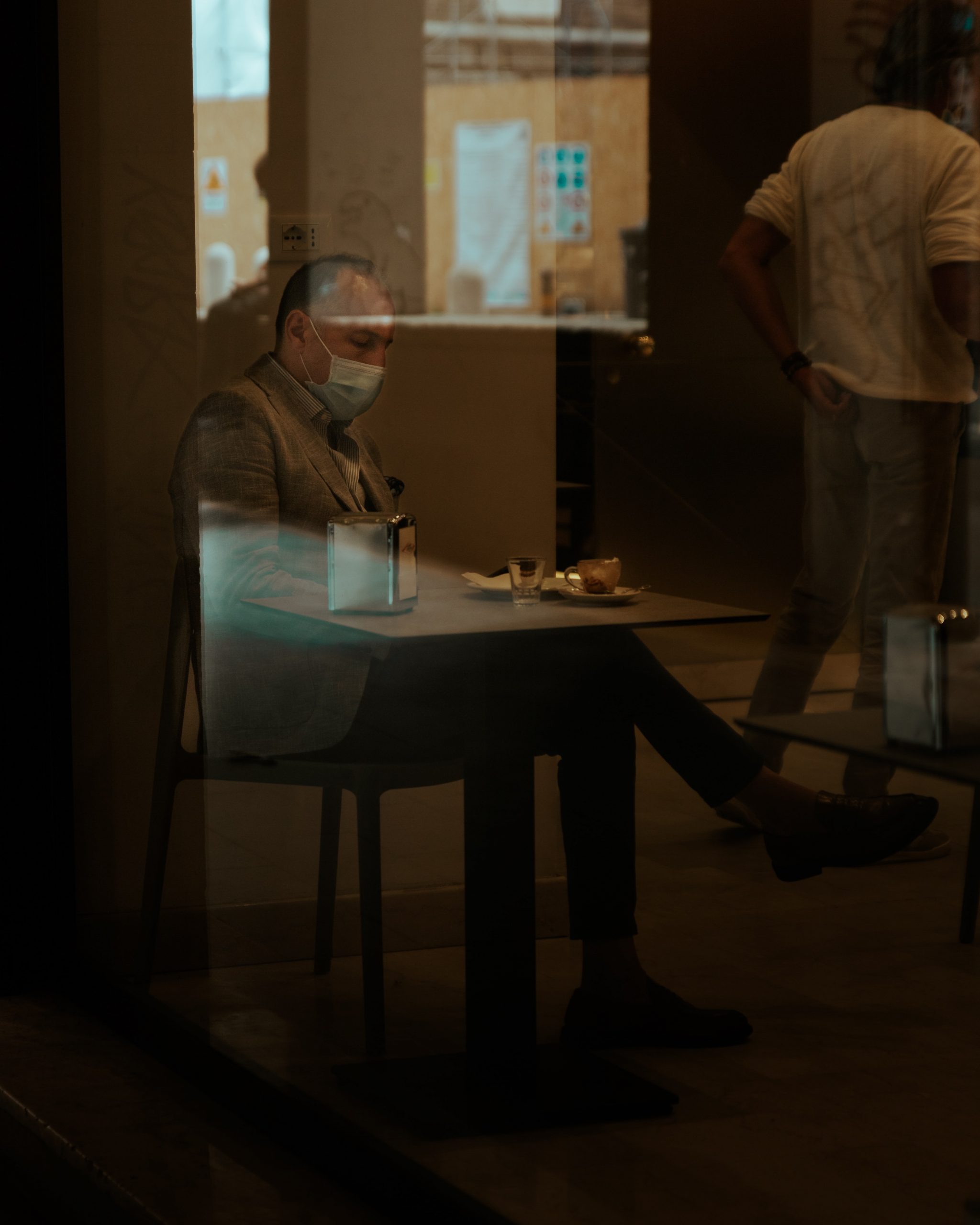
Sources
.https://www.yoursun.com/coronavirus/coronavirus-likely-has-changed-forever-the-way-restaurants-are-designed-for-better-and-for-worse/article_40cb6451-196d-502b-8d87-2af05e3bc178.html?utm_source=Sailthru&utm_medium=email&utm_campaign=Issue:%202020-08-28%20Construction%20Dive%20Newsletter%20%5Bissue:29367%5D&utm_term=Construction%20Dive
.https://www.fsrmagazine.com/expert-takes/what-restaurant-future-will-look-after-covid-19
.https://www.qsrmagazine.com/outside-insights/how-covid-19-will-impact-restaurant-design
.https://www.dezeen.com/2020/05/07/restaurant-interiors-trend-report-coronavirus-pandemic-roar/
.https://stories.zagat.com/posts/the-future-of-pandemic-restaurant-design
.https://modernrestaurantmanagement.com/the-future-of-restaurant-design-post-covid-19/
.https://rddmag.com/design/3089-designing-restaurants-in-a-post-pandemic-world
